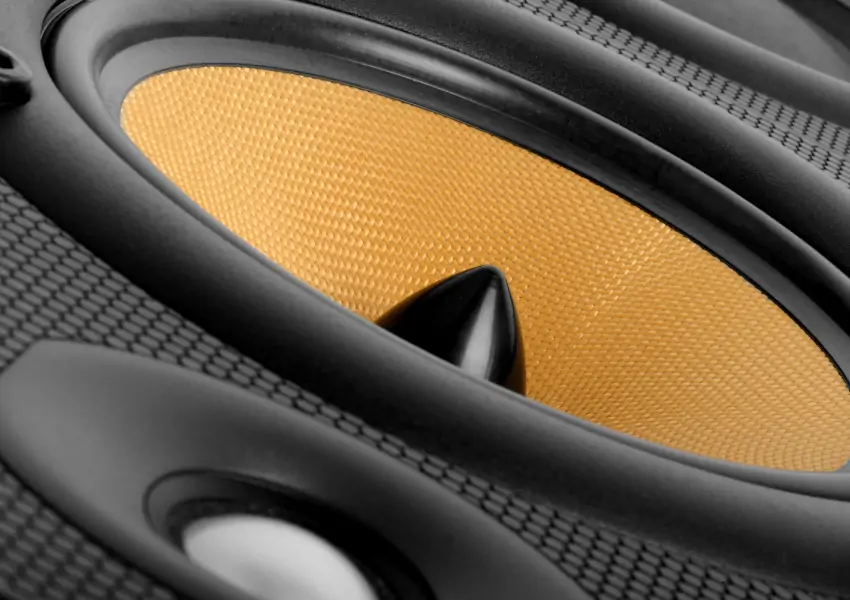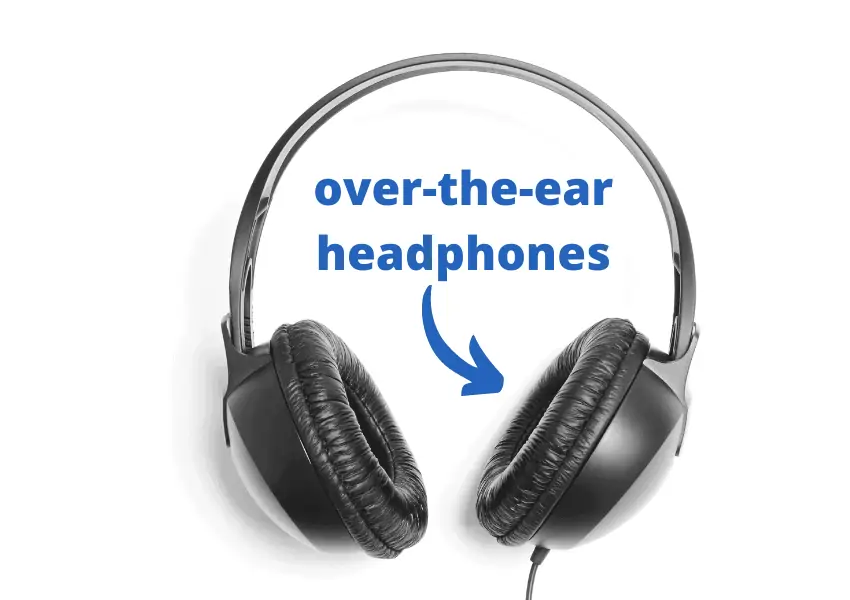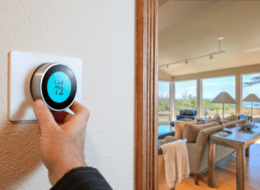
- Wearable speaker neckband
- Comfortable, ergonomic design
- Compatible with Bluetooth devices like a phone
- Operates up to 12 hours at half volume (6 hours at full volume) for every charge.
- Winner of the European Design Award
- Stable transmission up to 33 ft

- Simple, easy setup for smart & non-smart TVs
- Comfortable, padded over-the-ear headphones
- Includes optical, AUX, and RCA input cables
- "FastStream" Bluetooth prevents lip sync delay
- Connectivity up to 100 ft
- Compatible with other Bluetooth-enabled devices, like phones
Over 1 in 3 older adults experiences hearing loss, which can bring with it a great degree of frustration, isolation, and loneliness into a senior’s life.
Wireless TV headphone listening aids can be hugely helpful in this regard, allowing the elderly better and easier access to the entertainment they enjoy without struggling to hear.
It can be tough to figure out the best TV listening aids for the hearing impaired.
There’s so much to consider, with a lot of different styles and technologies to choose from.
- Some wireless TV headphones are compatible with hearing aids while others aren’t.
- Some allow other people to hear the TV, while others mute it for everyone other than the primary listener.
Overall, we consider Avantree Wireless Television Headphones to be the best wireless TV headphones for seniors, which offer soft, comfortable ear pads along with balanced sound and hearing aid compatibility.
We’ll cover all these details and more as we delve into the world of TV listening aids to help you determine what will work best for your senior loved one in their particular situation.
Why TV Hearing Aids are Great for Elderly Seniors
Like anything, watching TV isn’t healthy when overdone, but in moderation, watching television can provide a number of benefits that can help offset some of the effects of hearing loss. Entertainment, education, connection, stress relief, and inspiration are just a few of the benefits!
Listening to music specifically also brings a wealth of benefits to mental and physical health, happiness, and wellness – including reducing depression and the risk of cognitive decline – but only if you can hear it!
Wireless headphones for TVs can help make watching television and listening to music much more satisfying and enjoyable for the elderly individual with hearing loss – and for those around them!

As many family members and roommates of hearing-impaired television watchers can attest, the extra-loud volume can be disruptive or hard to tolerate at times.
TV listening aids can help to enable the senior with hearing loss to hear their program, without blasting others out of the room. But did you know that many wireless TV headphones can be used in other situations as well?
For example, some TV listening aids can:
- Connect to stereo systems, bringing music back into an elderly audiophile’s life
- Pair with cell phones, enabling better connection with the important people in the senior’s life
- Enhance hearing in live conversations
The 10 Best Wireless TV Listening Aids for Elderly Seniors
Let’s dive into our round-up of the top ten best TV listening aids and wireless TV speakers for the elderly.
1. Monodeal Wireless TV Headphones
These Monodeal Wireless TV Headphones offer a great listening experience at a smart price. The adjustable headband and padded, over-the-ear design is comfortable for extended use and compatible with many hearing aids. These TV headphones are easy to set up, use and recharge.
Features:
- Easy to use and set up
- Long listening range
- Noise cancellation and excellent sound quality
- Power-saving auto-off feature
- Easy to recharge on included charging dock
These Monodeal TV headphones come with a standard 3.5mm AUX jack and RCA connections, so they are compatible with televisions as well as many other audio devices, including laptops, computers and even AM/FM radios. An optical converter is available from the company upon request.
The Monodeal’s strong 2.4GHz RF radio signal extends up to 100 feet, even through walls. A senior can keep listening to their program even while heading to the kitchen for a snack!
These wireless television headphones feature hi-fi sound with no audio delay for excellent clarity and sound quality, including bass and treble enhancement without distortion. This makes the Monodeal a great choice for seniors who appreciate good audio quality.
Their noise cancellation properties help block out competing sounds for a more satisfying listening experience.
The Monodeal features a rechargeable battery with a 20-hour battery life. It has a smart auto-off feature to conserve power after a few minutes of inactivity. To recharge the battery, and ensure a full charge whenever needed, simply place the headset on the included charging dock when not in use.
Technical Specifications
- Speaker / Headphone Style: Over-the-ear headphone
- TV Audio Out Compatibility: RCA, 3.5mm AUX headphone jack, optical (upon request)
- Transmitter Type: Radio Frequency
- Power Source: Rechargeable battery with charging dock
- Battery Life: 20 hours
- Range: 100 feet
Pros
- Compatible with computers, radios and TVs
- Good sound quality
- Comfortable over-the-ear design
- Compatible with many hearing aids
Cons
- Seniors with pacemakers should not use RF
2. Avantree Wireless Headphones
These Avantree Wireless TV Headphones feature soft earpads and an adjustable headband so they are comfortable to wear, even for extended periods. They are optimized for balanced sound with an emphasis on clarity, and compatible with most hearing aids.
In fact, these TV headphones can even be used with a cell phone to improve telephone calls!
Features:
- Compatible with most hearing aids
- Designed for clear, balanced sound
- Soft earpads and adjustable headband for comfortable extended listening
- Use with cell phone to enhance hearing on telephone calls
- Noise cancelling
These Avantree TV headphones are compatible with most televisions or computers via a wide selection of audio out ports, including RCA, optical, Bluetooth, USB, or AUX headphone jacks, so they should be able to work with 99% of television sets.
They auto-connect for a super easy set up.
They can also be used to enhance audio with other Bluetooth-enabled devices, such as cellphones, which can make a difference in a hard-of-hearing senior’s ability to enjoy telephone calls with friends and family.
The noise-canceling properties help block out background sound, so it’s easier to hear the television show – although it will be harder to hear the phone ring or someone speaking in the room as well!
These Avantree TV headphones can reach up to a 100-foot range, although it must be kept clear of walls, people, and other obstructions for clear performance.
These wire-free television headphones use rechargeable batteries, but they don’t come with a charging dock. Instead, they are charged much like a cell phone, using a phone charger or USB port. It only takes about 3 ½ hours to charge completely, and the battery lasts for nearly 40 hours.
Technical Specifications:
- Speaker / Headphone Style: Over-the-ear headphones
- TV Audio Out Compatibility: RCA, optical, Bluetooth, AUX or USB
- Transmitter Type: Bluetooth
- Power Source: Rechargeable battery
- Battery Life: 40 hours
- Range: 100 feet
Pros
- Very comfortable to wear
- Compatible with most hearing aids
- Easy to set up and use
- Long battery life
Cons
- Recharging via phone charger may be slightly challenging for some seniors
3. TV Ears Digital Wireless Headset
The TV Ears Digital Wireless Headset features earbuds that go into the ear canal, and a headset that hangs down, resembling a stethoscope. These TV headphones are ideal for couples who want to listen to the television at different volumes. They are designed to enhance dialog to make it easier to hear and understand spoken words – even whispers!
Features:
- Voice clarifying circuitry enhances dialog for ease of listening
- Listen to the television at the same time as using the headset
- Extra loud volume enables some seniors to remove their hearing aids and still hear the TV
TV Ears is designed to work with almost any television, and the initial set up is simple.
Plan on replacing the earbud tips every few months and the rechargeable battery every year or two.
TV Ears don’t work with hearing aids, but because they are classified as an “Assistive Listening Device” they are able to offer an extra-loud volume, about twice the standard maximum! Many seniors find it works well to simply take out their hearing aids while using this headset.
The charging dock is capable of charging two headsets at once, which is an excellent feature for couples who both want to wear them. (Second headset is sold separately.) Because TV Ears allows the television to play at any volume while the headset is in use, a second headset may or may not be needed.
Seniors who watch more than a few hours of TV per day may want to invest in a second headset because these last only about 4-6 hours on a single charge. They then require about 6-8 hours to fully charge again.
TV Ears are easy to use and recharge for many seniors, but some may find them a bit more challenging than some of the other options out there.
To recharge the headset, you must first turn it off, place it front-first in the charging cradle, and then click it into place. Some seniors may find it easy to miss a step, and end up with a drained battery when they were expecting it to be charged.
It’s also important to be sure that the headset is facing towards the transmitter during use. If a senior has visual challenges or confusion, they could have trouble telling which way is forward, or remembering to put them on correctly, and the sound quality could suffer.
Technical Specifications
- Speaker / Headphone Style: Earbud headphones
- TV Audio Out Compatibility: RCA, optical, 3.5mm AUX, coaxial
- Transmitter Type: Infrared
- Power Source: Rechargeable battery with charging dock included
- Battery Life: 4-6 hours
- Range: About 25 feet, with direct line of sight
Pros
- Two listeners can enjoy television at different volumes
- Charging dock works with two headsets, if desired
- Enhances dialog for better clarity
- Lightweight and compact
Cons
- A little more complicated to use and recharge than the simplest alternatives
- Some seniors find in-ear headphones to be uncomfortable
- Recommended to replace ear tips every 3 months and specialized rechargeable battery every 1-2 years
- Short battery life
4. ChairSpeaker Voice Enhancing TV Speaker System
The ChairSpeaker Voice Enhancing TV Speaker System places the speakers on the chair itself – not your loved one’s head – so it’s completely comfortable and compatible with hearing aids! With the sound so near the listener’s ears, it doesn’t have to be very loud or fill the entire room with sound.
There are no batteries to recharge, and it couldn’t be simpler to use!
Features:
- Optional voice enhancing technology makes it easier to understand dialog
- Speakers are on the chair, not the head
- Compatible with hearing aids
- No batteries to change or charge
The ChairSpeaker’s voice enhancing technology reduces background noise on the TV that competes with dialog, so it’s easier to hear what’s being said even at a lower volume. This voice-enhancement feature can also be turned off if desired for more immersive sound.
The ChairSpeaker is compatible with most televisions and is easy to set up. It may or may not mute the television, depending on the TV itself.
The ChairSpeaker can be easily fitted to any sofa, headboard, or chair using its ball flex jointed arms – it even holds tight to lift recliners!
The speakers are powered by an 18-foot cable that can easily reach any standard outlet. You won’t have to worry about battery changes or recharges – just make sure the cable stays well away from walkways to avoid a tripping hazard.
Technical Specifications
- Speaker / Headphone Style: External speakers
- TV Audio Out Compatibility: RCA, Digital Optical Audio
- Transmitter Type: Infrared
- Power Source: AC wall outlet
- Battery Life: N/A
- Range: 33 feet with direct line of sight
Pros
- Compatible with hearing aids
- No uncomfortable headsets
- No battery changes or charges to worry about
Cons
- Be sure cable is secured out of walkway to avoid tripping accidents
5. SuperEar Personal Sound Amplifier
The SuperEar Personal Sound Amplifier is a portable, handheld sound amplification system which can be used to watch television – or enhance hearing in many other situations. Because it’s so small and doesn’t require a connection to the television, the SuperEar can be a great choice for travel!
Features:
- Comes with earbuds as well as on-ear TV headphones
- Slips in a pocket or use the included belt clip for easy portability
- Standalone device doesn’t need to be connected to television
SuperEar has been around for over 30 years, enhancing hearing for a fraction of the cost of a hearing aid.
This completely portable system features a small but powerful microphone that increases the volume of all ambient sound. This means it will also amplify background noises, so it may not deliver the best results in a crowded restaurant or other noisy venues – although it can work well to give the microphone unit to the person speaking.
The SuperEar is powered by a single AAA battery – which comes included! Each battery will last for approximately 30 hours of use.
The SuperEar comes with a pair of soft earbuds which also feature an over-the-ear hook to help keep them comfortably in place. It also comes with an on-ear style headphone, so there are different options for comfort and discreet use.
Technical Specifications
- Speaker / Headphone Style: Earbuds and on-ear headphones
- TV Audio Out Compatibility: N/A
- Transmitter Type: wire
- Power Source: 1 AAA battery
- Battery Life: approximately 30 hours
- Range: 100 yards
Pros
- Inexpensive
- Portable
- Can be used for enhancing hearing in conversations in addition to television
Cons
- May not be useful in areas with lots of background noise
- Not compatible with hearing aids
6. Pyle Wireless Portable Speaker Soundbox
The Pyle Wireless Portable Speaker Soundbox looks a lot like an old-fashioned portable radio. Set up and use are super easy, and it’s one of the top choices when it comes to simplicity.
Features:
- Lightweight and portable
- Works with most televisions and other media systems
- Easy to set up, use and recharge
- Option to plug speaker directly into wall to avoid battery recharges
The Pyle comes with several audio connection options to work with most televisions and other media systems.
The transmitter base plugs into the television and the receiver speaker can easily be transported around a range of up to 100 feet. It does use radio frequency (RF), so should be avoided by seniors with pacemakers.
Recharging the Pyle is easy, too: simply set it on the base. The battery life is around 8 hours, and it takes only about 3 hours to fully recharge. The Pyle shuts off automatically after a few minutes of inactivity to conserve power.
The speaker also comes with an AC adapter port, so it can actually be plugged into the wall outlet, if preferred. This would negate any need to recharge the batteries, at the cost of portability. It could be a good option for a senior who can’t or doesn’t want to deal with recharging it at all. The adapter cord must be purchased separately.
The TV may or may not be muted when the Pyle is in use, depending on the TV itself. In most cases the TV speaker will be muted with headphone jack connection but not with RCA connections. The Pyle has a headphone output jack to allow for private listening when desired.
Technical Specifications
- Speaker / Headphone Style: Portable wireless speaker
- TV Audio Out Compatibility: RCA, Analog headphone jack, Digital optical
- Transmitter Type: 2.4 GHz Radio Frequency (RF)
- Power Source: Rechargeable battery or AC outlet
- Battery Life: 8 hours
- Range: 100 feet
Pros
- Simple to set up, use and recharge
- Option to plug speaker into wall outlet
- Lightweight and portable
Cons
- People with pacemakers should avoid RF
7. Monster Boomerang Neckband Speaker
The Monster Boomerang Neckband Speaker is a great choice for seniors with Bluetooth television sets, and for active audiophiles! It’s optimized for good music and theatre-style sound quality, and it’s designed to be worn for extended periods, even outdoors or in wet conditions!
Features:
- Use with cell phone, stereo, televisions or other Bluetooth-enabled devices
- Built in microphone for easy use with cell phone
- Excellent sound and music quality
- Waterproof – great for outdoor use
- Hearing aid compatible
The Monster’s soft, silicone material is comfortable, even against bare skin. The Monster Boomerang is lightweight and ergonomically designed for comfortable wear. It’s easy to slip on around the neck, without messing around with headphones or earbuds.
It can connect to any bluetooth-enabled device, including certain televisions, stereos systems and cell phones. The Monster Boomerang even features a built-in microphone, so it’s easy to use it in conjunction with a cell phone for calls.
The Monster’s external speakers are worn so close to the ears that they can provide excellent sound quality at a low volume that won’t disturb others. Some seniors enjoy using them to listen to music or chat on the phone while walking outdoors.
The Monster Boomerang’s battery charge lasts for about 12 hours, and fully recharges in only 90 minutes using a USB-C cable.
Technical Specifications
- Speaker / Headphone Style: External speakers (worn around neck)
- TV Audio Out Compatibility: Bluetooth
- Transmitter Type: Bluetooth
- Power Source: Rechargeable battery
- Battery Life: 12 hours
- Range: 33 feet
8. ZVOX Sound Bar
The ZVOX Sound Bar isn’t about making it louder (although it certainly can do that) – it’s about making it clearer. Their dialog-clarifying technology isolates voices from the background music, sound effects and other noise. It brings voices forward so they can be heard and understood clearly over the rest.
Features:
- Dialog-clarifying technology
- Output-leveling feature quiets loud commercials
- No battery changes or recharges
This sound bar is designed to sit beneath the television and stay there. It plugs into the wall, and there are no battery changes to worry about, but it’s not very portable.
Dialog-clarification technology with six levels of voice boost emphasizes speech and minimizes non-vocal components of the sound track. This enables seniors to hear what is said more clearly, without having to turn it up louder!
The ZVOX also features output leveling technology, which quiets loud commercials and softens jarring sounds. It also boosts quieter audio levels, so the end result is a nice even volume, without all the extremes.
Set up is simple. Connect one wire to the television and plug the ZVOX into the wall outlet. Turn the volume on the television speakers down and use the included ZVOX remote to control the sound. The remote features large, easy-read buttons and simple controls. Some cable or satellite remote to control the ZVOX, if preferred.
Technical Specifications
- Speaker / Headphone Style: External subwoofer speaker
- TV Audio Out Compatibility: Optical
- Transmitter Type: N/A
- Power Source: AC wall outlet
- Battery Life: N/A
- Range: N/A
Pros
- Boosts dialog, making it easier to understand
- Audio leveling technology evens out extreme volumes
- Hearing aid compatible
- Simple set up
Cons
- Works with optical audio out port only
9. Sennheiser Assistive Listening Headphones
The Sennheiser Assistive Listening Headphones is a stethoscope-style in-ear headset that offers excellent sound quality, speech optimization, and excellent comfort and durability. It’s our choice as the best premium option available!
Features:
- Choose from 3 speech optimization settings
- Works well with various devices including plasma TVs, hi-fi systems and radios
- Durable construction designed to last
- Simple to use and recharge
The Sennheiser can connect to audio outputs on most stereos or radios as well as televisions, for seniors who want to better hear and enjoy their music.
It uses a radio frequency system which provides an outstanding range of around 100 feet, even through walls. This is an especially nice option for seniors who may be enjoying music through their headset. However, keep in mind that seniors with pacemakers should avoid radio frequency.
The Sennheiser is very easy to use. The headset automatically turns on when placed on the head.
It’s easy to recharge the Sennheiser by setting it into the included charging dock. The battery lasts for up to about 9 hours, and then takes about that long to recharge. Some seniors opt to buy a second battery, which conveniently can charge while the headset is in use, providing almost endless availability.
The Sennheiser transmitter includes a small external microphone, which can be placed in front of sound sources if desired. People can even speak into it to enhance conversations!
They are also remarkably more comfortable and durable than most earbuds or other stethoscope-style headsets.
Technical Specifications
- Speaker / Headphone Style: In-ear headphones
- TV Audio Out Compatibility: 3.5mm stereo jack plugs, RCA, SCART socket
- Transmitter Type: Radio frequency (RF)
- Power Source: Rechargeable battery
- Battery Life: Up to 9 hours
- Range: 100 feet
Pros
- Easy to use and recharge
- Connect to an assortment of televisions and stereos
- Comfortable and durable construction
Cons
- Seniors with pacemakers should avoid RF
10. Onebridge Hearing Aids
Onebridge Hearing Aids offers many of the benefits of traditional hearing aids at barely a fraction of the cost. Resembling behind-the-ear hearing aids, these handy devices can enhance not only the television listening experience, but can truly change the life of some seniors with mild to moderate hearing loss!
Features:
- 4 modes optimize listening in different settings
- 5 earplug options
- Active noise cancelling technology
In addition to volume control, these Onebridge hearing aids feature four modes to optimize the listening experience in different settings, including indoor, outdoor, noisy streets and daily life.
Onebridge hearing aids are lightweight, moisture-proof and ergonomically designed for comfort. They fit into the ear canal with a soft plastic hook over the back of the ear. It comes with a set of five soft, medical-grade ear tips to fit comfortably in a variety of ear canal shapes and sizes.
The batteries in these amplifiers can run for around 55 hours between charges – and require only four hours to fully recharge! Two mini USB cables are included, so both aids can be charged at once.
Technical Specifications
- Speaker / Headphone Style: In-ear
- TV Audio Out Compatibility: N/A
- Transmitter Type: N/A
- Power Source: Rechargeable batteries
- Battery Life: 55 hours
- Range: N/A
Pros
- Inexpensive alternative to hearing aids for some mild to moderate hearing loss
Cons
- Sometimes they make a whistling sound if not inserted correctly, or volume is too high
Types of TV Hearing Aids: Speakers vs. Wireless TV Headphones
Most TV hearing devices fall into one of two categories, either speakers or headphones.
Speakers

Speakers tend to be a popular choice among seniors who have hearing aids, who are looking for something simple to set up and use, and who don’t have to worry about disturbing others.
– Easy to Use
Portable speakers are generally easy to use. From a simple set up to an easy-adjust volume knob, they can be a great choice for seniors who don’t want too many confusing options.
– Compatibility with Hearing Aids
One of the biggest strengths of speaker systems is that one never has to worry about their compatibility with hearing aids. A major drawback is their potential to disturb other people in the room (or anywhere else in the home) if they get turned up too loud.
Wired vs. Wireless Speakers?
Portable speaker systems tend to be wireless, so they are easy to move around without worrying about wires getting tangled underfoot. However, wireless operation means they rely on battery power. Whether they use regular, replaceable batteries or a built-in battery with a charging stand or cable, someone needs to be sure they are always powered or they won’t work at all.
Seniors who have trouble seeing, remembering or understanding how to recharge a battery may find that wired speakers are a better option.
Headphones

When a senior wants to watch TV around others without disturbing them, headphones make much more sense than speakers. Headphones also tend to offer better noise-cancelling properties than speakers do. However, most headphones aren’t compatible with hearing aids.
The three main styles of headphones are in-ear (earbud style), on-ear, and over-the-ear.
In-Ear Headphones

In-ear (earbud-style) headphones, go into the ear canal. They tend to be the smallest, lightest and most discreet option. However, earbud-style headphones aren’t compatible with hearing aids, and some seniors find them to be uncomfortable.
Look for earbuds made of softer materials, or those that come with tips in various sizes, for the most comfortable experience.
Over-the-Ear Headphones

Over-the-ear headphones look similar to ear muffs. A headband connects two speakers, one over each ear. The bigger they are the better the sound quality tends to be (although this does vary).
Some seniors do find they are too bulky for their liking, but they can be used with most hearing aids. Many folks also find over-the-ear headphones more comfortable than earbud-style headphones. These also tend to be a popular headphone option for CD players.
On-Ear Headphones

On-ear headphones are smaller and lighter than over-the-ear models, and can fit more easily into a handbag for travel. They tend to press into the ears a little bit, so many seniors find they aren’t comfortable to wear for extended periods, but for short programs they don’t usually pose much of an issue. They don’t usually work well with hearing aids, since the design requires the on-ear headphone padding to press right against where a hearing aid protrudes.
What to Consider When Selecting Wireless Headphones for TV
There is so much to consider when selecting a TV listening aid! Let’s jump right in!
Compatibility: How Does it Connect with the Television?
How does the device connect to the TV? The three top ways are via RCA plugs, optical outputs or Bluetooth connection.
A few older television sets out there may not have any audio outputs. For these, look for listening aids that include small microphones that can be set in front of the speaker.
RCA Jacks

RCA jacks are round plugs with red, white and sometimes yellow connections.
Optical Outputs

Some newer televisions use optical outputs, which look like plugs with a small square end. They transmit sound information via fiber optic cables.
Bluetooth

Some newer smart TVs come with bluetooth capability built in. Bluetooth is nice because it doesn’t need any wires or cables. However, you’ll need to be a little more tech-savvy to set it up, and the sound quality does tend to suffer a bit as compared to the other options. Bluetooth also tends to require more power, so it can drain batteries more quickly.
How Does the Device Transmit Sound?
Listening aids designed specifically for television use include a transmitter, which connects to the television through an audio out port. The transmitter then sends the sound signals to a receiver which plays the sound through a speaker. The signals can be sent through a wire, radio waves, infrared signal or bluetooth connection.
Wire
Wired devices boast the best sound quality, but are rarely used because the cords are inconvenient and can be easy to trip over.
Radio Frequency
Most devices use radio frequency (RF) to transmit sound information via radio waves. RF has a pretty long range, and can sometimes even reach to another room or penetrate walls.
Seniors with pacemakers should avoid RF devices.
Infrared
Infrared (IR) has a somewhat limited range and it requires a clear line of sight between the device and the receiver – much like a television remote control must point directly at the TV to work.
Bluetooth
Bluetooth connections are convenient because they’re wireless, and are built into the television. Their range is fairly short, and they tend to drain batteries more quickly than other transmitters.
How Easy is it to Use?
Most listening devices are not overly complicated, but some models may be challenging to operate for seniors who have memory loss, vision deficits or poor dexterity in their fingers.
Depending on their limitations, look for something with large, simple volume knobs and an easy, straightforward method of recharging or changing the batteries.

In the case of headphones, how easy would it be for the senior to put them on – or in – their ears.
What about maintenance requirements? Will the senior be able to keep up with any recommended cleaning or upkeep? In many cases, earbud type headphones can be wiped clean with an alcohol wipe as needed, but sometimes earbud tips need to be replaced periodically. Speakers can often be cleaned with a dry microfiber cloth.
How Easy is it to Set Up?
Don’t forget to consider how easy or complicated the set up is. Some devices are very simple to set up, while others may require a little bit of technical know-how. Is there someone who can help the senior get it set up initially and show them how to use it?
Where are the audio out ports on the television? Most TVs have these in the rear, which may be hard for a senior to get to.

It may be difficult to reach the ports on wall-mounted TVs – and once the transmitter is plugged in, there may be limited options for where to place it.
Is it Portable?
For many seniors, portability won’t be a factor in their choice of listening device – but for others, it will. If the senior wants to take the device to a hotel or family member’s house, they’ll need something portable. In most cases, headphones tend to be better choices than speakers in terms of portability.
Portability around the house is another consideration. Will the senior always be sitting in the same spot to watch TV, or are they looking for something they can wear as they move around the house a bit? Some like to listen to music or other programs as they work on chores, or just not miss a beat as they take a bathroom break.
Is it Compatible with Hearing Aids?
Some TV listening devices are compatible with hearing aids and others aren’t.
Any earbud-style headphone device that’s designed to go into the ear canal won’t work with most hearing aids or hearing aid alternatives like personal sound amplifying products (PSAPs).
External speakers often work well for seniors who wear hearing aids, as long as they tend to watch television alone. However, these can get loud sometimes. If there is someone else in the home that might be disturbed by the volume, over-the-ear headphones may be a better option.
Some brands of hearing aids have special transmitters that work specifically with their products. They can send the audio information directly into the hearing aid itself! Contact the hearing aid manufacturer directly to see if they offer this type of product.

The key to finding headphones that work with hearing aids is to find a pair that is comfortable, and whose speakers are a centimeter or more away from the hearing aid’s microphone. Hearing aids that nestle completely in the ear canal will be more compatible with TV headphones than those with microphones behind the ear.
Some seniors find it works for them to just take out their hearing aids while listening to their headphones.
What’s the Power Source?
How will the TV listening device be powered? Some plug into the wall outlet directly, while others use a battery.
Wall (AC) Outlets

Devices that plug directly into the wall (AC outlets) never have to be charged – but they do need to stay close to the wall! For some seniors that’s not really an issue, but for others it can be a dealbreaker. Also, the cords and wires can be unsightly, and even unsafe, if they aren’t kept tucked safely out of the walkway.
Battery Power

Battery powered devices have the advantage of being wireless, and they’re more portable than those that plug into the wall. Some devices use standard AA batteries, while others feature built-in batteries that must be recharged periodically.
Devices that use standard replaceable batteries can be a convenient choice for seniors who don’t want to mess around with recharging it – or who may forget to do so. However, this means they’ll need to keep plenty of batteries on hand. Also, seniors with conditions that challenge finger dexterity, such as arthritis, may have trouble opening a small battery compartment.
Seniors who wish to avoid dealing with battery changes may prefer to opt for a rechargeable device. Many can simply be set on the charger when not in use. These can be a nice option, as long as the senior can remember to charge it, can understand how to do so, and can see the indicator lights.
Whether you opt for a rechargeable device, or standard batteries, pay attention to the process of recharging or replacing the batteries, as well as the estimated battery life. If the device doesn’t have power available when the senior is ready for it, it’s effectively useless!
What is the Maximum Listening Range?
For seniors who will be watching and listening to TV only from their living room chair or bed, range may not be a big consideration. However, for those who like to move about the room or house with headphones – or who sit further away from the television than most – the device’s range will come into play.
Will Others Be Watching TV Too?
Many televisions put sound out only through one active out port. This means that the sound may only come through the device, and not the television’s speakers. In the case of TV headphones, no one else watching will hear any sound.
If multiple people will be watching at once, check that the television has multiple audio out ports, or look for features in the device that support multiple listeners, such as dual headphones with separate volume controls.
Will Others Disturbed if There’s Too Much Noise?
Are there others around who may be disturbed by a loud television set? If so, headphones may be a better choice than external speakers.
What’s the Return Policy?
Check out the return policy before finalizing your purchase. In case there ends up being an issue with compatibility, ease of use or battery life, it’s nice to know that you can get your money back and try something else..
Of course, it would be much more convenient to skip that step altogether, which is why we’re putting together this guide for you! By knowing exactly what you need ahead of time, hopefully you’ll be happy with your new listening device from day one!
Other Ways to Boost TV Sound
Don’t forget about these tried and true methods for improving the television-watching experience. They may or may not make a big difference in your loved one’s case, but they could be worth a shot!
Closed Captioning / Subtitles
Don’t forget to turn on the subtitles or closed captioning to help make out the dialog. All television and cable providers are required to include accurate captioning for the hearing impaired.
You can find this option in the settings menu of most televisions.
Adjust the Equalizer Settings

If the television has equalizer (EQ) settings, you may be able to find better audio quality by fiddling with them a bit. Generally speaking, if you turn the bass levels down and the mid and treble levels up, dialog will be easier to hear and understand.
Put the TV in a Corner
If the speakers are on the back of the TV set, placing it in the corner of a room allows the walls on either side to bounce the sound waves back toward the center of the room, amplifying the volume.
Finding the Best TV Listening Aid is Worth the Effort
Even though it can be kind of complicated to sort through all the options to find the best TV listening aid for your senior loved one’s particular needs, it’s worth the effort.
Being able to enjoy TV, movies, and music again – without disturbing others in the home – is a great feeling, and a life-changer (or marriage-saver!) for many.
There’s a good chance that our best overall pick, the Avantree Wireless Headphones will work for you. It’s compatible with hearing aids and most television sets. It’s comfortable, easy to set up and to use, and it delivers great sound with a focus on vocal quality.
However, it very well may be that something else entirely would much better suit your senior’s needs!
We’d love to have your feedback! Leave us a note in the comments below and let us know what your experience has been with hearing loss and TV listening aids!
Last update on 2022-01-29 / Affiliate links / Images from Amazon Product Advertising API















